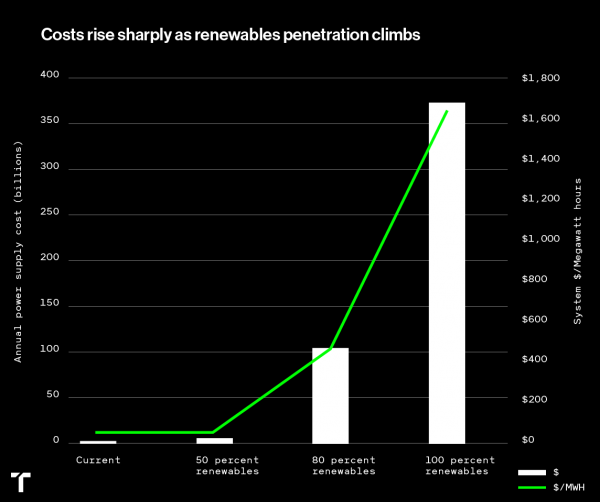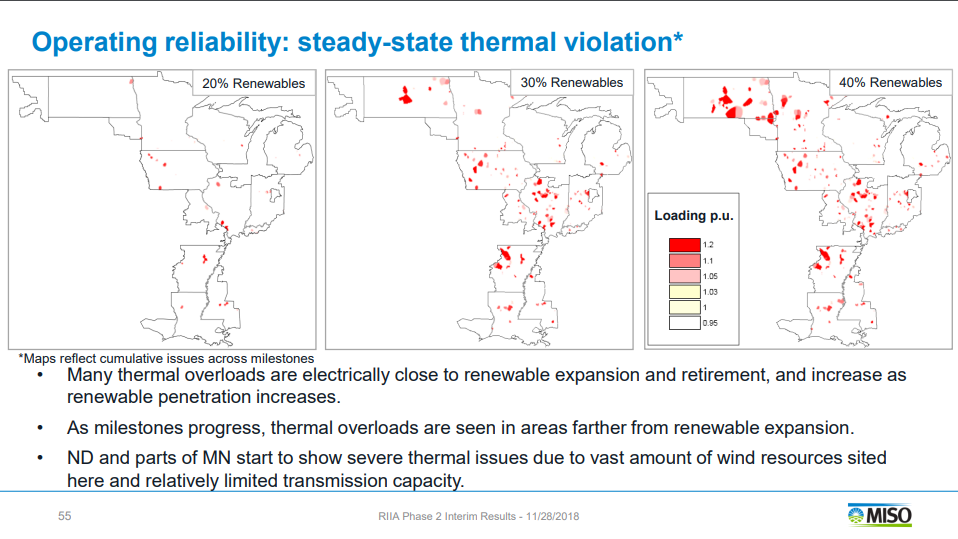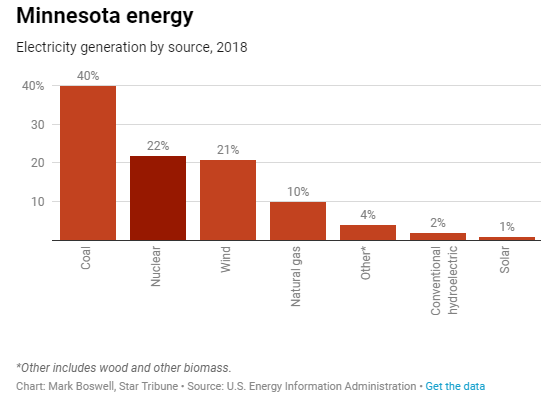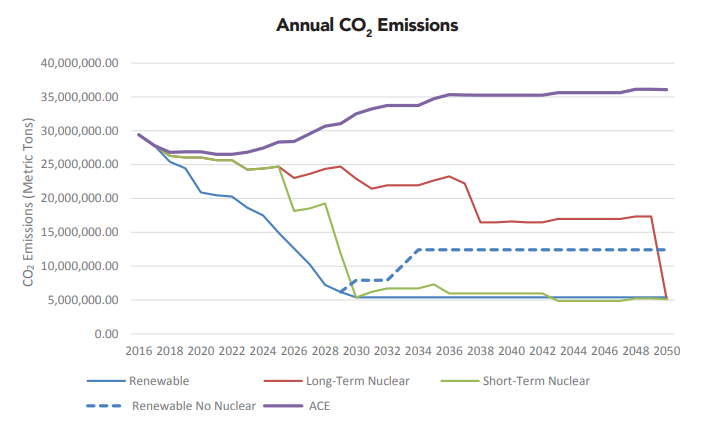Star Tribune: Technology, Cost Could Hamper Efforts for 100 Percent Carbon-Free Grid in Minnesota by 2050
On April 20th, the Star Tribune ran a story entitled “Technology, Cost Could Hamper Efforts for 100 Percent Carbon-Free Grid in Minnesota by 2050.” It was good to see the paper acknowledging that the policies proposed by Governor Walz and House DLF’ers will be expensive and the technology needed to attain this goal (without the use of nuclear and large hydro) does not exist.
American Experiment has worked hard to establish itself as a serious, and credible organization on energy issues, and as much as I wish the Star Tribune would seek out our perspective for stories like these, the fact that our arguments are being made by people who support more renewable energy only strengthens our position to make them. I’ve included the Star Tribune article below along with my comments.
By midcentury, coal and natural gas could be erased from Minnesota’s electricity grid, replaced by carbon-free power sources, particularly wind and solar.
That is the goal of Gov. Tim Walz, who is pushing legislation for a totally clean grid by 2050. Ditto for Xcel Energy with its target of 100% carbon-free electricity in the same year.
Reaching that target is a challenge, though, both because the technological path to completely carbon-free energy isn’t clear yet and because it may be expensive, particularly the last mile from 80% clean energy to the total banishment of fossil fuels.
IO: This is absolutely true.
In fact, research from MIT has shown the cost of electricity increases 10-fold as the penetration of wind, solar, and battery storage increases from 50 percent to 80 percent of electricity generation. Increasing wind and solar penetration from 80 percent to 100 percent quadruples the cost of electricity, rising from more than $400 per megawatt hour (13 times more expensive the cost of electricity generated at the Sherburne County coal-fired power plants in Minnesota), to more than $1,600 per megawatt hour (53 times more expensive than Sherco!). Furthermore, this estimate assumes the cost of batteries will be three times lower than it is today.

“There’s no doubt that the last 20% is the most difficult and probably the most expensive,” said Doug Scott, a vice president at the Great Plains Institute, a nonprofit energy research group in Minneapolis.
Walz sees his goal as a way to ensure reliable, affordable electricity while supporting a cleaner environment and the clean-energy industry. But a bill setting the 2050 goal has yet to get a Senate hearing, and opponents point to the uncertainties of cost and technology.
New battery technologies will likely be needed to meet the massive storage demands of a grid as energy sources shift from coal to resources such as wind turbines and solar panels.
IO: Batteries, in their current form, are not only prohibitively expensive, they are totally unworkable. Just 24 hours of battery storage in Minnesota would cost more than $133 billion, based on the Tesla battery installed in South Australia, and we would need several weeks, or even months, of battery storage to accommodate a grid that relies solely on intermittent renewable energy sources.
What’s worse, the batteries that are currently under contract in California are only designed to last for 20 years. This means battery technology is not only enormously expensive, but it is simply unable to do the job of providing long-term, reliable electricity at any cost. Couple this with the fact that batteries in Minnesota will have the additional challenge of operating at reduced capacity because of cold weather, and the prospects of a wind, solar, and battery future seem ever more implausible.
Plus, Minneapolis-based Xcel — and government regulators — will need to figure out how nuclear power might fit in the picture. Its reactor licenses with the federal government are set to expire by the mid 2030s.
Xcel, Minnesota’s largest utility, is confident that 80% carbon-free energy can be reached by 2030 using existing technology, including nuclear. Beyond that, the company is counting on advances that are largely on the drawing board today to reach goals it announced in December.
IO: Existing nuclear power is, by far, the most affordable source of carbon-free power available. The two plants operating in Minnesota churned out steady, around-the-clock electricity for approximately $42 per megawatt hour in 2017, according to data from the Federal Energy Regulatory Commission. There are currently six nuclear plants in the United States seeking to extend the lives of their nuclear fleets from 60 to 80 years. This must be on the table in Minnesota if DFL lawmakers truly believe climate change is an “existential threat.”
“The way I look at the 2050 goal, we have 30 years to get there,” said Ben Fowke, Xcel’s CEO. “I am open to anything that works cost-effectively.”
Coal is still king for electricity production in Minnesota, providing 40% of the state’s electricity generation, though it’s retreating as utilities — particularly Xcel — plan to close coal plants by the mid 2020s.
In at least one way, Minnesota has an advantage in the quest to replace coal and other fossil fuels.
Compared with other states, Minnesota has some of the best wind resources in the country, energy analysts said. Wind now provides about one-fifth of electricity generation in the state.
Plus, new wind farms in Minnesota appear to be as cheap as new gas-fired power plants, even without federal tax subsidies for renewable energy, according to Bloomberg New Energy Finance.
IO: Wind resources in Minnesota are better than they are in many states, but comparing Bloomberg New Energy Finance’s Levelized Cost of Energy (LCOE) numbers for wind and new natural gas isn’t an apples-to-apples comparison because natural gas is dispatchable, meaning it can produce electricity on demand, whereas wind produces electricity intermittently, which means we must still have coal or natural gas available to generate electricity when the wind isn’t blowing.
Furthermore, BNEF unsubsidized cost estimates of $38 per megawatt hour for wind are likely unrealistic. I say “likely” because BNEF’s refuses to make the underlying assumptions for their calculations public, unless we want to pay $70,000, as you can see in the email exchange below. Such secret assumptions should be treated with skepticism.

While solar power comprises about 1% of electricity generation in the state now, and is more expensive than new gas power currently, the cost is likely to fall.
“The whole trend of all these technologies is that they get less expensive as time goes on,” Scott said.
But since wind doesn’t always blow and the sun doesn’t always shine, managing the grid becomes more difficult as constant power sources like coal fade away.
As wind and solar become more prominent, however, there is a need to make them more stable sources of power.
Batteries will be necessary to store power until it’s needed, and that work has begun. It helps that the benchmark price for battery storage as calculated by Bloomberg New Energy Finance has declined 76% from 2012 — 35% from the beginning of 2018.
Utilities have begun planning large battery projects, including Xcel in Colorado. Xcel also expects pilot projects in Minnesota over the next few years. The first fully commercial grid battery in Minnesota was launched last year by the Ramsey-based electricity cooperative Connexus Energy.
Grid batteries usually use the same chemical technology, lithium ion, as batteries for personal electronics and electric vehicles. Most lithium-ion grid batteries store two to four hours of electricity. But with a carbon-free grid, batteries will need to economically warehouse several days or even weeks of power, particularly during seasonal lulls in sunshine and wind.
“Long-duration storage needs to be an order of magnitude cheaper than lithium ion,” said Jesse Jenkins, a postdoctoral fellow at Harvard University’s Center for the Environment.
Betting exclusively on wind, solar and battery storage to achieve a 100% carbon-free grid “would be a big mistake,” given the economic and technical challenges, concluded a recent study co-authored by Jenkins in the scholarly journal Joule.
IO: This is exactly what American Experiment has been saying all year. The intermittency of wind and solar is a major problem that we have only begun to consider. Nuclear and large hydroelectric power would more reliably, and much more affordably, generate electricity without CO2 emissions, despite the Governor’s belief that wind, solar, and batteries are more affordable than these alternatives.
Another big hurdle for carbon-free generation is the need for more electricity transmission and distribution capacity.
In 2016, a group of Upper Midwest utilities, including Xcel, switched on the last leg of a $2.1 billion transmission megaproject called CapX2020. It was aimed partly at freeing up power-line capacity for more wind energy.
“CapX2020 is really not enough,” said Sam Gomberg, senior energy analyst at Union of Concerned Scientists. “The grid is fully subscribed. It is at capacity.”
IO: Transmission is a major cost driver of renewable energy on the grid that must be accounted for. According to the Renewable Integration Impact Assessment study conducted by the Midcontinent Independent Systems Operator (MISO), the regional grid operator, system overloads are much more likely to occur as wind and solar reach a 40 percent penetration into the electricity market. This means Minnesota, and the entire Midwest, will need to spend billions of dollars on transmission infrastructure to accommodate more wind and solar on the grid, which will increase the cost of electricity for consumers.

The question of nuclear energy
Another 22% of Minnesota’s electricity is generated by nuclear energy, now the country’s largest source of carbon-free electricity.
But it’s still controversial among environmentalists, notably for the longstanding problem of radioactive waste disposal.
Plus, some nuclear plants in states with deregulated electricity markets aren’t competitive with generators fueled by cheap natural gas. Minnesota’s electricity business is regulated, and Fowke said Xcel’s nuclear plants have been continually improving their operations and cost efficiency.
The federal licenses for Xcel’s three nuclear reactors — one in Monticello and two at Prairie Island near Red Wing — expire in 2030, 2033 and 2034, respectively.
To get an idea of the nuclear fleet’s importance, let’s assume Xcel achieves its goal of 80% carbon-free energy in Minnesota by 2030. The company would drop back to 60% carbon-free power if all three reactors were closed by 2035 and not replaced by any new clean energy sources.
Building large new nuclear plants is a nonstarter these days, given the enormous expense and the huge cost overruns experienced by two projects under construction in the Southeast.
New nuclear-power technologies — much smaller reactors with lower price tags — are being developed. But it’s not clear if they will succeed commercially; and they, too, produce radioactive waste.
The best bet for extending nuclear power’s shelf life may be re-licensing existing plants for several more years of operation.
“If it can be done cost effectively and safely, pushing nuclear licenses another 20 years is an option and one that a lot of companies are considering,” said Jenkins of Harvard’s Center for the Environment.
Count Xcel among them. “I think we need to be open to it,” Fowke said. “We have more work to do to see what the costs and benefits might be.”
Xcel’s nuclear plants opened in the early 1970s and were originally licensed for 40 years. In the late 2000s, Xcel petitioned the U.S. Nuclear Regulatory Commission (NRC) to re-license the plants for another 20 years. Many nuclear operators did the same.
Xcel may signal its long-term plans for the nuclear plants in a regulatory filing this summer.
IO: Nuclear and coal plants have a tougher time competing in “deregulated markets” because of federal subsidies for wind and solar, as well as state-level mandates for renewables that artificially wrest market share away from these generation sources. Furthermore, coal and nuclear plants are less flexible than natural gas, which means that it is harder for them to ramp down their electricity output when there is a lot of wind on the system.
In some instances, coal and nuclear plants must pay people to take the power they put on the grid when prices are negative. Prices go negative because the federal wind production tax credit, the main subsidy received by wind, allows them to make $24 per megawatt hour to generate electricity whether it is needed or not. This is an example of a broken market mechanism that unfairly disadvantages other generators.
On emissions, our paper found that increasing Minnesota’s renewable energy mandate, but allowing its existing nuclear plants to close, would be counterproductive to the goal of reducing carbon dioxide emissions. The dotted line shows CO2 emissions doubling after existing nuclear plants are shuttered in the 2030’s. Minnesota lawmakers should be encouraging Xcel to seek an additional license for these plants to run them for as long as possible.
IO: Our study found that new nuclear power plants should also be on the table. There’s no question the nuclear plants under construction in Georgia have been poorly managed, but South Korean reactors have had a better track record in terms of cost, and delivering a product without the same degree of project delays, and these nuclear plants have just been granted key safety and design approvals by the Nuclear Regulatory Commission.
The second policy recommendation in our report was to legalize new nuclear power and for Minnesota lawmakers to designate a task force to explore least-cost solutions for nuclear power—including Generation III reactors built by South Korean firms and Small Modular Reactors (SMR).
Carbon capture and sequestration
As far as technology that’s in the pipeline, scientists and businesses are working on several concepts, including one called carbon capture and sequestration. Like nuclear, it’s controversial among some environmentalists, who see it as perpetuating fossil-fuel industries.
The idea is to separate carbon dioxide created from fossil-fuel generation and then store the stuff in underground rock formations.
“It’s technologically feasible, but very challenging,” said Frank Wolak, an economist at Stanford University, where he directs the Program on Energy and Sustainable Development. “You could sequester it, but would it be cost-effective?”
Carbon capture received a black eye from a $7 billion, vastly overbudget power plant in Mississippi, which was supposed to burn coal and store about two-thirds of its carbon-dioxide emissions. Last year, the utility that owns the plant scrapped coal and carbon capture and is instead just burning natural gas.
A $1 billion carbon-capture facility at an existing coal plant near Houston opened in 2016 and on budget. The Petra Nova project, which was funded partly with a $190 million federal grant, is the only one of its kind in the country.
Petra Nova sells its captured carbon to a Texas oil-field operator. Oil companies have long used compressed carbon dioxide to scour out the last bits of petroleum in conventional wells.
In North Dakota, “Project Tundra” would build upon the success of Petra Nova, according to its developers, led by Grand Forks-based Minnkota Power, an electricity cooperative prominent in northwestern Minnesota.
Project Tundra would entail an approximately $1.3 billion facility built next to a large Minnkota coal-fired power plant in central North Dakota. Minnkota is applying for a $15 million engineering and design grant from the federal energy department.
Xcel doesn’t have any carbon capture projects in the works, though the company is open to the technology. “If the numbers work, yes, I would like to see carbon capture work,” Xcel’s Fowke said.
IO: There’s no doubt carbon capture technology needs to be proved out, but the fact that it would be possible to provide dispatchable, constant electricity from coal makes it leagues more feasible than intermittent wind and solar, which would still need a fossil fueled coal or gas plant to provide electricity when the wind isn’t blowing or the sun isn’t shining.
Next steps
There also are carbon-free technologies that, while nascent, show long-term promise. One involves storage of the sun’s heat energy. (Solar panels utilize the sun’s light.) Another is the use of excess wind and solar power — a likely occurrence in a totally clean grid — to create hydrogen fuel through a process called electrolysis.
“I am technology agnostic on how we get there,” said Xcel’s Fowke.
Walz and DFL legislators are pushing the 2050 plan this year at the Capitol, attempting to increase the state’s existing goal of 80% carbon-free power by 2050.
The legislation is likely to pass the DFL-controlled House. But a carbon-free-by-2050 bill has not yet received a hearing in the Republican Senate.
If the legislation fails, the clean grid issue isn’t likely to go away.
Amid alarm over climate change, carbon-free energy goals are being debated across the country, with some states setting aggressive goals.
“It’s great to have that aspiration from companies like Xcel and the governor,” said Scott of the Great Plains Institute.
IO: The legislation pushed by Governor Walz and the DFL House do nothing to lift the ban on existing nuclear power plants and they do not allow large hydro to qualify for their ‘carbon free” standard. This means they are attempting to solve a problem they call an “existential crisis” by using the least effective, and more expensive means possible.
This goes to show that Walz and the House DFL’ers are not the adults in the room, and left to their own devices they would force Minnesota to unnecessarily spend billions on wind and solar that are unreliable, unaffordable, and unable to actually meet their stated goals.
The Strib should be commended for publishing this article, and hopefully they continue to publish more articles that examine the costs of these proposals.

